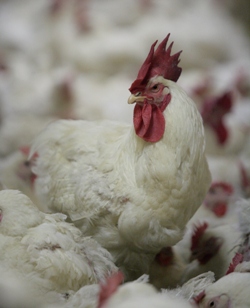Breeder chickens show different behaviors

Behavior patterns for animals develop early in life. Environmental conditions play a significant role in development of social hierarchies. Some aggression is necessary.
However, when female chickens are fearful, they tend to remain on slatted areas. If they do leave the slatted areas, they are often repeatedly mated by several males. This can result in injury or death.
Research on this matter was carried out by the University of Arkansas in Fayetteville, AR, USA.
According to researchers S.M. Sullivan and N.B. Anthony, behaviorists contend that years of cage rearing and artificial insemination of elite populations without selection for behavior traits has caused a failure for males to perform enough courtship behaviors and a failure for females to properly respond by crouching.
Many of the factors that affect rate of mating are; dominance, ratio of male to females, specific breed differences, space, accessibility of males to females, how tolerant individual males are to other males, individual differences in libido, learned behaviors and conditioned responses.
Recorded were 26 different behaviors. These behaviors were then combined into 3 aggressive categories and 1 non-aggressive category. It appeared that more aggression occurs at 20% production than at 50% production.
There were differences between male lines and between time periods. There were no differences of individual aggressive behaviors for production periods except for circling (perhaps a precursor to waltzing). Fertility of lines A x White Rock started high and remained high, lines A x A and White Rock x White Rock started high, dropped significantly, and then returned. Mortality of males was the highest for A males crossed on White Rock females.
Interestingly, there were no mortalities for males crossed on the A female line. The female affect on male aggression is quite evident. There are differences due to hen effects among all lines. Best fertility at 20% production in lines crossed with each other and lines crosses with White Rock males. There appear to be minimal differences between commercial broiler lines crossed on White Rock lines, apart from some individual aggressive behaviors.
Source: Proceedings of the 2011 International Poultry Scientific Forum, Atlanta, GA, USA
Join 31,000+ subscribers
Subscribe to our newsletter to stay updated about all the need-to-know content in the poultry sector, three times a week. Beheer
Beheer








 WP Admin
WP Admin  Bewerk bericht
Bewerk bericht